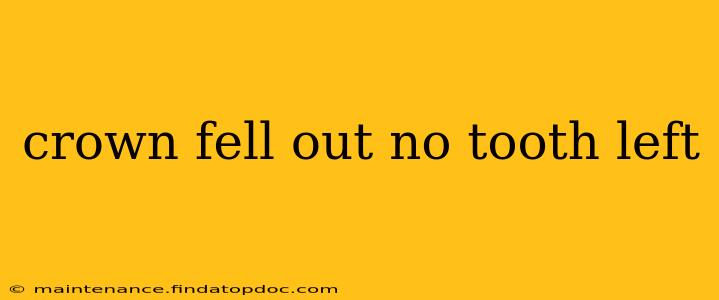Losing a dental crown is a common dental emergency, especially if the underlying tooth structure is compromised. It can be alarming to find a crown has fallen out, leaving behind an exposed tooth or even an empty socket. This guide will walk you through the steps to take if your crown falls out and there's no tooth left underneath.
What Happens When a Crown Falls Out and the Tooth Isn't There?
When a crown falls out and the underlying tooth is missing, it means the tooth has likely been severely damaged or decayed before the crown was placed. The tooth may have been extracted (pulled) completely or broken down to the point where only a small portion, or none, remains. This situation requires immediate attention from a dentist.
What Should I Do if My Crown Fell Out and There's No Tooth Left?
1. Stay Calm: Panicking won't help. Take a deep breath and follow these steps.
2. Locate the Crown (If Possible): If you can find the crown, rinse it gently with water and store it in a safe place. Your dentist might be able to re-cement it.
3. Inspect the Area: Carefully examine the area where the crown was located. Note any signs of infection, such as swelling, pain, or bleeding.
4. Rinse Your Mouth: Gently rinse your mouth with warm saltwater to clean the area and help prevent infection.
5. Contact Your Dentist Immediately: This is the most crucial step. A dentist needs to assess the situation and create a treatment plan. Don't delay seeking professional help.
6. Manage Pain and Swelling (if any): Over-the-counter pain relievers like ibuprofen can help manage discomfort and swelling. Apply a cold compress to the area to reduce inflammation.
How is This Problem Treated?
Treatment will depend on the extent of the damage and your dentist's assessment. Options may include:
- Immediate Extraction: If the remaining tooth structure is minimal or non-existent and there's significant infection, extraction might be necessary.
- Dental Implant: A dental implant is a titanium post surgically placed into the jawbone to replace the missing tooth root. Once the implant has integrated with the bone, a new crown can be placed. This is considered the most permanent and stable solution.
- Bridge: A bridge is a prosthetic device that spans the gap where the missing tooth was. It's cemented to the adjacent teeth.
- Partial Denture: A partial denture is a removable appliance that replaces one or more missing teeth.
What are the Causes of a Crown Falling Out?
Several factors can contribute to a crown falling out:
- Decay or Infection: Untreated decay or infection under the crown can weaken the underlying tooth structure, leading to crown displacement.
- Trauma: A blow to the mouth or significant biting force can dislodge a crown.
- Poor Oral Hygiene: Inadequate brushing and flossing can contribute to decay and gum disease, affecting the crown's stability.
- Wear and Tear: Over time, the cement holding the crown in place can wear down.
- Improper Fit: In some cases, a poorly fitted crown can loosen and fall out.
How Can I Prevent My Crowns from Falling Out?
- Maintain Excellent Oral Hygiene: Brush and floss thoroughly twice a day.
- Regular Dental Checkups: Schedule routine checkups and cleanings with your dentist.
- Avoid Biting Hard Objects: Refrain from chewing on hard items like ice, pens, or fingernails.
- Inform Your Dentist About Any Discomfort: If you experience any sensitivity or looseness in your crown, report it to your dentist immediately.
Is it Normal for Crowns to Fall Out?
While dental crowns are designed to be durable and long-lasting, it's not uncommon for them to come loose or fall out over time. Various factors can contribute to this, and it's essential to address the issue promptly to prevent further complications.
Remember, always consult your dentist for any dental concerns. This information is for general knowledge and shouldn't replace professional dental advice.
